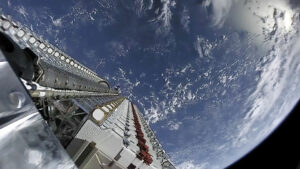After 72 flights over three years, NASA’s Ingenuity helicopter has made its final flight on Mars. It was the first aircraft to operate and fly on another planet, a huge step forward in space exploration. Its final images show why it will never fly again.
Images sent back to NASA’s Jet Propulsion Laboratory in California show that at least one of the little helicopter’s carbon fiber rotor blades was damaged on Jan. 18.
A short flight goes wrong
The mission team had scheduled Ingenuity to make a “hop,” a short vertical flight. This was so they could note its exact location. While it was in the air, they lost communication with the chopper. Ingenuity sends information to the Perseverance rover and then the rover relays the information to the mission team on Earth. But this pathway broke down and Ingenuity was unable to send information to the rover.
Flight 72. That’s the final flight for our Ingenuity #MarsHelicopter.
Ingenuity and its team proved that powered, controlled flight on another world was possible. #ThanksIngenuity. You may rest, but your legacy will continue to soar: https://t.co/uEe2ZAw2ML pic.twitter.com/9YlmWFpl2z
— NASA (@NASA) January 25, 2024
The team eventually restored communication the next day. They are still trying to figure out what caused the communication breakdown. However, NASA was able to view Ingenuity’s last images and look at some of the flight data. The images show that around 25% of one blade is missing. This is crucial for providing the thrust and balance to fly the little chopper.
The team is unsure if they will ever know the exact sequence of events that led to the damage. But there are two possible scenarios. Ingenuity may have experienced some kind of crash landing that broke the blade, subsequently halting communication. The second possibility is the reverse, a power or communication breakdown that caused problems during the landing.
“The historic journey of Ingenuity, the first aircraft on another planet, has come to an end. That remarkable helicopter flew higher and farther than we ever imagined and helped NASA do what we do best — make the impossible, possible. Through missions like Ingenuity, NASA is paving the way for future flight in our solar system and smarter, safer human exploration to Mars and beyond,” NASA representative Bill Nelson said in a statement.
A very successful experiment
Though it is a sad end, Ingenuity has achieved far more than anyone expected in its few years on the Red Planet. Initially, it was sent out as an experiment to see if it was possible to operate an aircraft on another planet. NASA had only planned for it to take five flights but it was so successful that they continued using it. It swiftly became a key player in the success of the Perseverance rover. The mission team would send Ingenuity to scope out interesting areas and pinpoint spots for the rover to analyze in more detail.
Teddy Tzanetos, the Ingenuity project leader, called the situation bittersweet. Ingenuity flew 14 times further and 33 times longer than NASA had planned. It survived Martian winters, dust storms, and three emergency landings.
“She’s tougher than any of us could have ever imagined. For a helicopter, going through a blade strike is typically the end and Ingenuity was able to do that and survive. We couldn’t be prouder of our little tough trailblazer,” Tzanetos told CNN.
The Perseverance rover is collecting samples hundreds of kilometers away from Ingenuity. Both have been in the Jezero Crater for a few years. Soon the rover will make its way west and eventually leave the crater. En route, it should pass within 300m of the helicopter and will try to get images of Ingenuity in its final resting place. Once Perseverance makes it over the rim of the crater, all communication will be lost.





